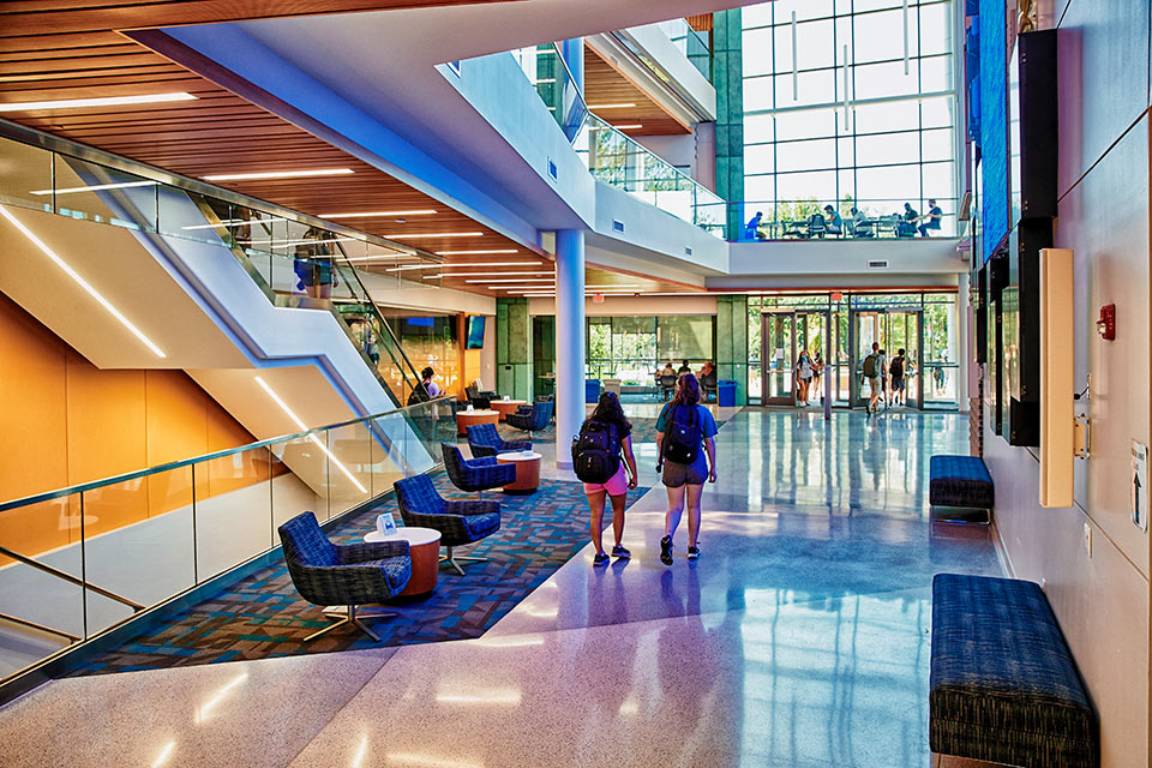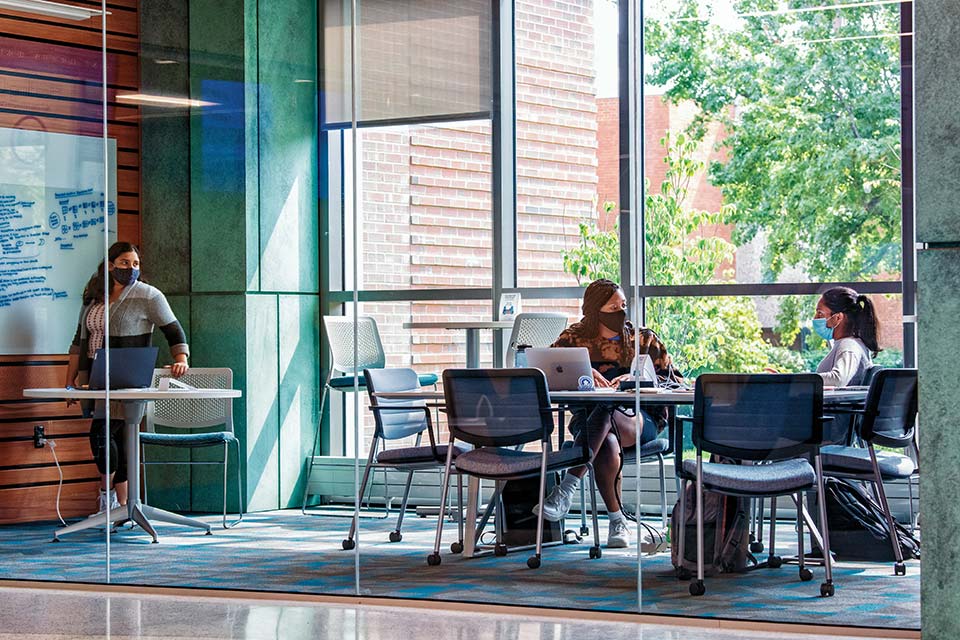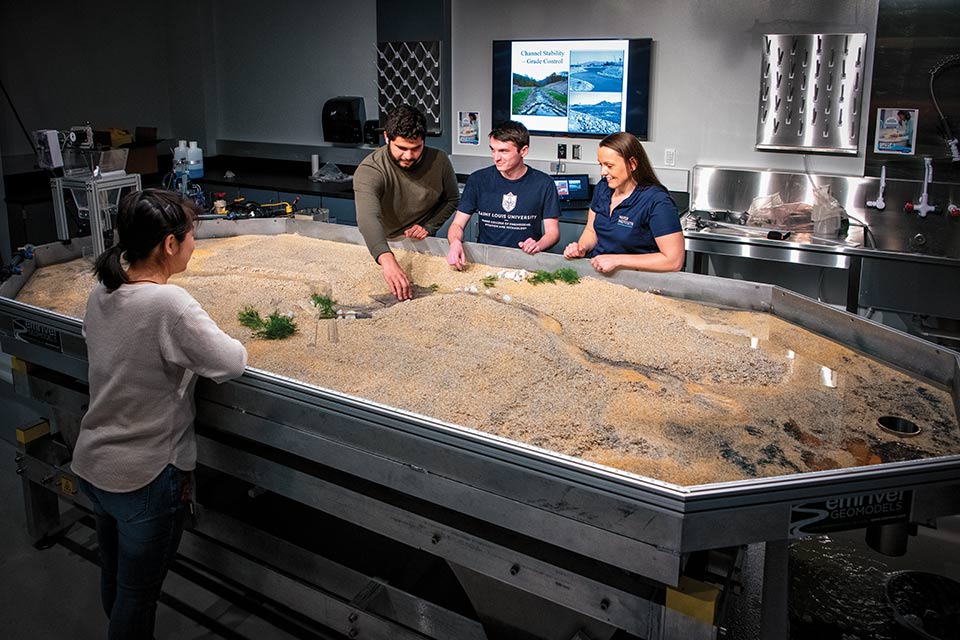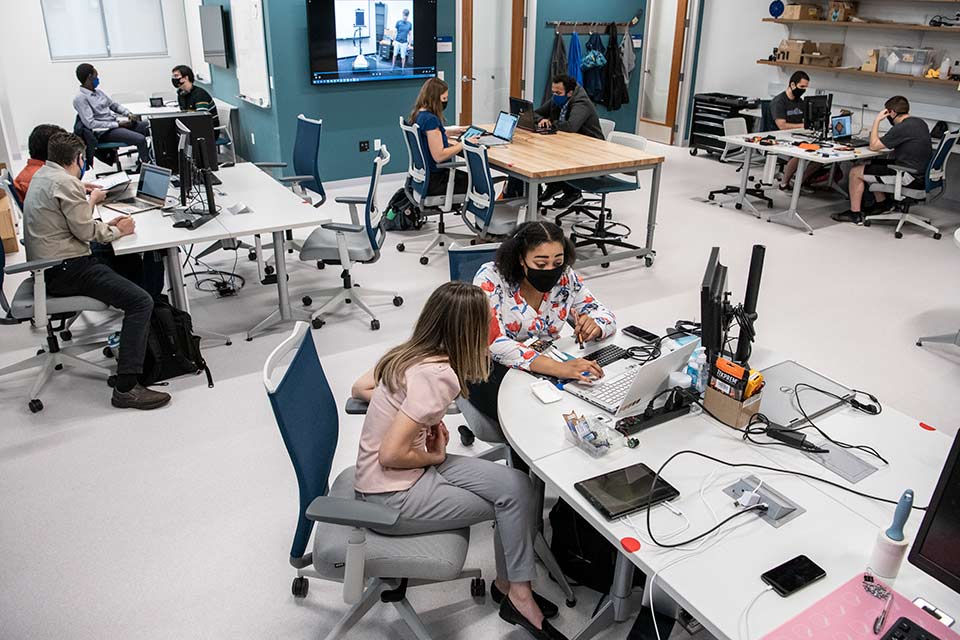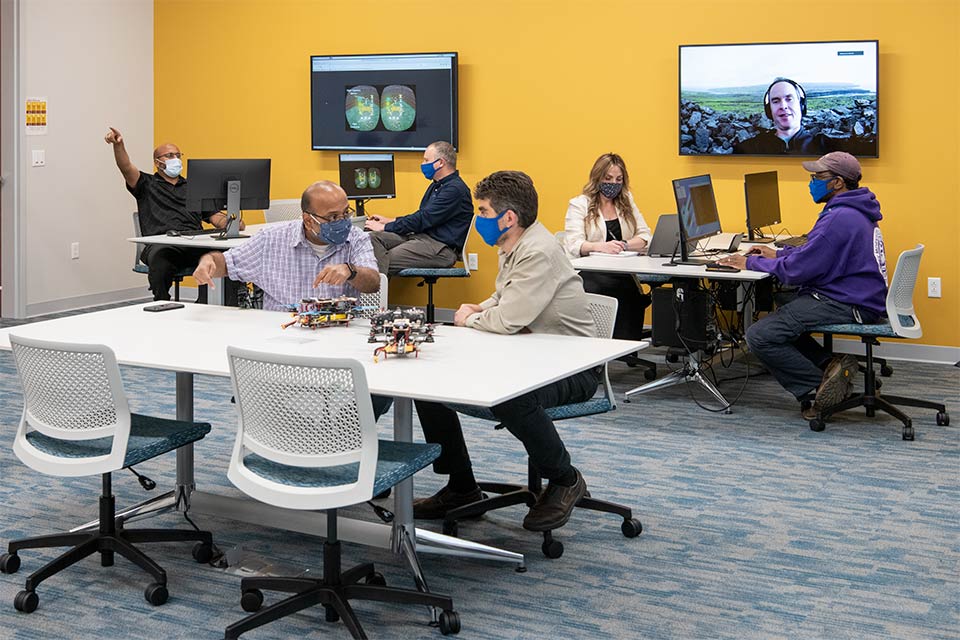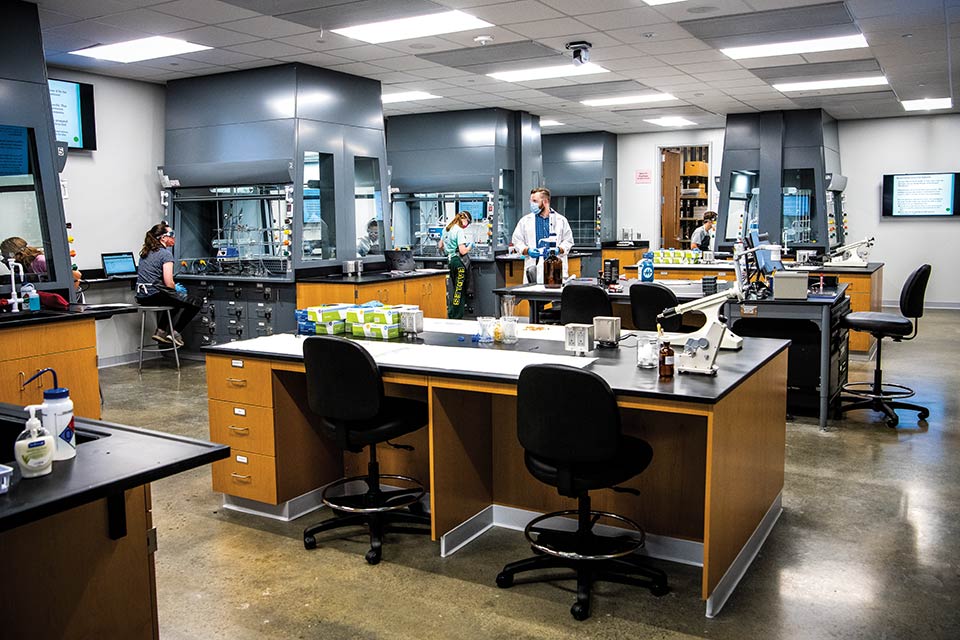Designed for Discovery
Saint Louis University’s new STEM building is home to some of the University’s most innovative research.
Saint Louis University’s Interdisciplinary Science and Engineering Building (ISE) was constructed with 125 tons of structural steel, 94 miles of power cabling, 8,000 cubic yards of concrete and a vision for STEM breakthroughs.
The three-story, 90,000 square-foot ISE Building represents the heart of SLU’s science, technology, engineering and math (STEM) programs. It was designed to enhance the University’s STEM offerings and its overall mission as a premier research institution.
feet of fiber-optic cable
data outlets
square feet of roofing systems
tons of reinforcing steel
The $50 million building is strategically located to attract students, faculty and staff across disciplines. It sits in the middle of the north quad near McDonnell Douglas Hall, home of Parks College of Engineering, Aviation and Technology, and Tegeler and Ritter Halls. Its layout invites visitors to walk through rather than around the structure.
A dynamic three-story video wall of calendar events, news and research updates beckons passersby to drop in. Large exterior windows and glass interior walls allow visitors to see SLU researchers and students engaged in discovery. The building’s transparent design also allows students and professors to benefit from working in natural light.
Flexible interior features enable researchers, faculty and students to break down research silos and talk across disciplines, not just among the hard sciences but also in the social sciences, arts and humanities. Flexible spaces also allow for both open and closed meeting spaces, as well as incubator space where ideas become projects or programs.
Open to All
University administrators anticipate that every undergraduate student will be assigned a class in the ISE Building during their time at SLU. They will gather in “scale-up” classrooms — integrated learning environments where the physical space is designed to discourage lectures and encourage interactions between small groups. The facility boasts 10,000 square feet of undergraduate research space.
Exposed staircases lead to large informal study areas where students and faculty can gather and have an exchange of ideas.
The building, completed in July 2020, houses lab space and teaching spaces for bioinformatics, biology, biomedical engineering, chemistry, neuroscience and computer science courses. It is home to the departments of computer science and computational/structural biology. It also is inhabited by a unique group of SLU researchers, centers and programs strategically chosen to help nourish collaboration across campus and the community.
WATER Institute
Researchers with the Water Access, Technology, Environment and Resources (WATER) Institute are working on critical and persistent water-related issues including access to clean water, reducing the impact of water-related natural disasters and protecting aquatic ecosystems. The institute brings together researchers in engineering and science, policy and economics, and public health and social justice.
The WATER Institute is the first research collective of its kind in the Midwest.
Dr. Elizabeth Hasenmueller, associate professor in the Department of Earth and Atmospheric Sciences and associate director of the institute, concentrates on the impact of microplastics on freshwater systems. Microplastics are tiny plastic particles less than one-fifth of an inch in diameter that are produced when larger plastic items break apart.
“Many of us focus on plastic pollution we can see,” Hasenmueller said. “But tiny microplastics can be harmful to wildlife if animals mistake them for food. Microplastics also move easily through the environment and can seep into the groundwater we use for drinking.”
Hasenmueller and her team of researchers, graduate and undergraduate students, collect groundwater samples at Cliff Cave County Park in south St. Louis County to understand how microplastics move through groundwater and affect underground ecosystems.
Dr. Amanda Cox, associate professor of civil engineering and director of the WATER Institute, is conducting collaborative research to develop methods for computing water volume in reservoirs across the country.
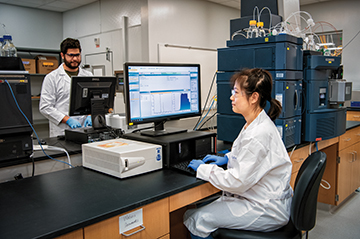
Over time, sediment builds up in reservoirs and reduces their capacity to hold water used by municipalities or for irrigation. Cox said it is crucial to have a better understanding of a reservoir’s volume, particularly in western states where there is rapid population growth and frequent droughts, and in eastern states, where reservoirs are used to store excess water during the flood season to mitigate potential downstream flooding.
WATER Institute researchers have partnerships with several organizations including the Environmental Protection Agency, the National Oceanic and Atmospheric Administration, the U.S. Geological Survey and GeoSLU, SLU’s own geospatial science and technology group, among others.
Social justice is an integral part of the institute’s mission. Dr. Craig Adams, Oliver L. Parks Endowed Chair and professor of civil engineering, leads the Water, Sanitation and Hygiene (WASH) initiative with the Mayan people in Belize.
Adams and his team, which includes members of the group Billiken Students for Clean Water, travel to Belize to assess water quality and assist with community water supply projects, including a high efficiency water filtration system that can remove viruses, bacteria, parasites and microplastics from drinking water.
PATH Group
Investigators with the People and Technology Horizon (PATH) group are finding ways to make technology adapt to humans rather than the other way around.
“Technological advancements have had an impact on almost every facet of life as we know it, and yet with innovation comes limitation,” said Dr. Jenna Gorlewicz, associate professor of mechanical engineering and a member of the PATH leadership team.
“Technology has enabled humans to interact in new ways, across new domains, but too often, the experience feels incomplete, tedious and unintuitive,” she said.
Through cross-disciplinary collaborations, PATH investigators use research in human language, interactions and communication to drive the design of next-generation technologies and increase their utility. PATH computer scientists, engineers and anthropologists work closely with diverse communities to address limitations from perspectives not often represented in the design of new technologies.
PATH brings together researchers and students from across STEM and the social sciences at SLU.”
Dr. Jenna Gorlewicz, associate professor of mechanical engineering and a member of the PATH leadership team
For example, in close collaboration with the pro-tactile deaf and blind community, PATH researchers are developing a haptic armband that can simulate different tapping sensations. Such a device could help facilitate remote conversation, which largely is a visual or aural task. Investigators also are developing ways to translate STEM educational content, such as graphs, diagrams and charts, into content that individuals can hear (through sounds), see (on screen) and touch (through vibrations).
“In technology design, we talk about accessibility, yet it often feels like an add-on or an afterthought,” Gorlewicz said. “PATH’s design approach is rooted in ensuring that accessibility is a non-issue. PATH works with diverse communities from the very beginning so as technology is created, it has the capacity to provide an intuitive, meaningful user experience.”
Gorlewicz said everything at PATH is rooted in the student experience.
“PATH brings together researchers and students from across STEM and the social sciences at SLU,” she said. “Seeing designs created by engineering students challenged by an anthropologist’s understanding of interaction, for example, is a highly unusual but valuable learning experience. I love that for our students. Perspectives are immediately challenged and strengthened because of the shared perspectives.”
AI@SLU
The leadership team of AI@SLU is charged with leveraging the University’s strengths across disciplines to explore how artificial intelligence (AI) can aid in tasks as diverse as diagnosing medical conditions, predicting crop productivity, preserving endangered languages and piloting drones.
“There is robust activity in AI at SLU,” said Dr. Michael Goldwasser, professor and chair of the Department of Computer Science and AI@SLU director. “Researchers in different areas may want to use AI or are already using AI but could benefit from our expertise. Our goal is to bring together these researchers, identify collaborations and help them use AI to advance their missions.”
AI@SLU received a Big Ideas planning grant in 2019 to build a framework for a larger initiative that would grow the sense of community at SLU and provide greater support for use of AI techniques. Goldwasser said the University made AI a priority with the hiring of several new faculty members who specialize in the field and with the development of a new graduate program in artificial intelligence.
The AI@SLU leadership team creating the framework for the larger initiative includes faculty from a variety of disciplines such as computer science, engineering, international business and medicine.
SLU projects underway that explore this transformative technology include:
- A cardiologist using AI to minimize observer variation and provide accurate diagnosis in the field of echocardiography
- A computer science fellow using AI to classify photos that can help locate victims of human trafficking
- In collaboration with GeoSLU and the St. Louis area’s Donald Danforth Plant Science Center, a computer scientist using AI to gather images of farm fields in Arizona for analyzing crop health
- A bioinformatics expert using AI to study how proteins fold, which could have an impact on drug design
- An aerospace engineer using AI to study how groups of drones interact and whether drones can operate autonomously or semi-autonomously
Goldwasser said while the AI@SLU planning group’s primary objective is harnessing the potential of AI across campus, it also is committed to exploring the ethical implications of the technologies and ensuring they do not exacerbate existing inequalities and biases or create new ones.
“We not only research what we can do with the technology,” he said. “We look at how it can affect criminal justice, medicine, education, anywhere AI can be used. We take a more holistic approach, which speaks to the University’s Jesuit ideals.”
Walter J. Ong, S.J. , Center for Digital Humanities
STEM meets the humanities on the ISE Building’s second floor.
Housing the Walter J. Ong, S.J., Center for Digital Humanities (CDH) in the ISE building makes it easier for faculty, staff and students in the burgeoning field of digital humanities to establish connections with SLU’s scientific and engineering community.
CDH faculty and staff help advance scholarship in the humanities by facilitating methodologies and appropriate digital tools to foster research and learning.
Dr. Phyllis Weliver, professor of English and director of the CDH, said the high-profile location is fitting for a center with an international reputation.
“Our center is unique among digital humanities centers because it not only is a focal place for learning about digital tools, which many universities offer, but we also have a team of digital technicians who are creating software and new tools,” Weliver said.
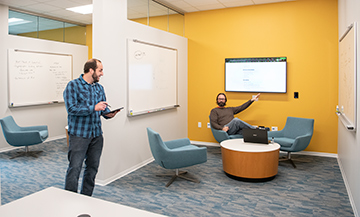
Among other achievements, CDH team members helped develop protocols for T-PEN, an online transcription service used with digitized images of texts in many forms, from personal letters to manuscripts. T-PEN has users worldwide, including the Newberry Library. CDH team members also helped establish the International Image Interoperability Framework, a set of best practices for digitizing image repositories in university archives, libraries and museums across the globe.
SLU is a pioneer in the field of digital humanities. Seeds were planted decades ago by longtime professors Walter J. Ong, S.J. (Grad A&S ’41), and Maurice B. McNamee, S.J. (A&S ’33, Grad A&S ’34, ’45), as well as Dr. Marshall McLuhan, who laid the cornerstone for the study of media theory.
Weliver said the CDH’s visibility in the ISE Building communicates to the SLU community what the international community already knows.
“Until now, the center mostly has been a College of Arts and Sciences resource,” Weliver said. “We hope that our new location will encourage interactions with other members of the University and generate new collaborations. The center is a part of SLU’s history and future, and we are excited for it to be showcased in the way it deserves.”
Center for Additive Manufacturing
Only imagination and inspiration are needed to access the SLU Center for Additive Manufacturing.
“Sometimes students and faculty walk in with sketches on napkins and a lot of arm waving,” said Dr. Andrew Hall, associate professor of biomedical engineering and center co-founder. “Our mission is to give anyone with an idea access to additive manufacturing so they can realize their plans or advance their research.”
The University has invested substantial capital and talent into establishing SLU as a regional hub for additive manufacturing, also known as 3-D printing and computer-aided design (CAD). The center’s team, with the support of a Big Ideas grant, created a state-of-the-art facility with at least 10 different types of technology. This includes more than half a million dollars’ worth of industrial 3-D printers, laser cutters and 3-D optical surface scanners. Hall said the center is open to students, faculty and the community.
The center was founded in 2019, and soon after, COVID-19 hit. Within a short period of time, the team developed user-specific N-95 respirators for the University health care provider community.
Team members collaborated with chemistry faculty to create microfluidic devices, merging cell culture and analytical measurement schemes together on the microscale. The team also collaborated with a biology professor to produce several 3-D models of a delicate fish skull so each of her students could have one for study.
Engineering and medical students use the center for help with capstone projects, and the team works closely with MEDLaunch, an incubator that brings together SLU students across disciplines to create medical devices.
Hall said the center’s future will encompass community outreach — helping larger manufacturers train their employees to use additive manufacturing and showing smaller manufacturers how additive manufacturing can grow their businesses.
The center grew out of the Tinker Lab, a small lab in Parks College founded by Dr. Sridhar Condoor, professor of mechanical engineering.
“It was a great little lab, but if you weren’t part of Parks, you had to work to find it,” Hall said. “This central location where people can walk by our big glass windows and see what we’re doing raises our visibility. It takes us to the next level. There is nothing like it in the St. Louis area.”
Chemistry Labs
With modular classrooms on the second floor and leading-edge teaching labs on the third floor, the chemistry department has created the ideal staging ground for scientific breakthroughs and engaging students in the process.
The number of general and organic chemistry labs nearly doubled when the chemistry department moved its teaching labs from the lower level of Monsanto Hall to the ISE Building.
Dr. Scott Martin, department chair and professor of chemistry, said the lab space was designed to offer chemistry students unprecedented opportunities for interdisciplinary collaboration with other faculty and students in the building, as well as give students access to state-of-the-art research instrumentation. This includes installation in April of a new nuclear magnetic resonance instrument, the preeminent technique for determining the structure of organic compounds.
Martin also noted that biochemistry students taking courses in the building are learning to analyze molecules with another tool called a polymerase chain reaction instrument — the gold standard for detecting viruses, including COVID-19.
“The new space allows for greater hands-on experiences for students who can make new molecules and analyze those molecules in attached instrument rooms,” Martin said.
Martin hopes the highly visible space will help ignite a passion for STEM education at the earliest stages of a student’s journey. All freshman and sophomore chemistry labs are held in the ISE Building.
“Students just seem happier in the new building,” Martin noted. “Going from the basement of a building constructed in the middle of the 1960s to this beautiful building with large windows overlooking a fountain and Grand Center is a great improvement. It demonstrates the University’s commitment to STEM research and the student learning experience.”
Martin also said the expanded space allows the department to offer more lab sections, which reduces scheduling conflicts that existed previously. Martin said next steps involve renovating the teaching space vacated in Monsanto Hall into research space for upper-level and graduate students.
By the Numbers
What it takes to build a STEM hub:
- 500 tons of reinforcing steel
- 125 tons of structural steel
- 30,000 square feet of roofing systems
- 2,500 feet of fiber-optic cable
- 1,875 data outlets
- 1,290 gallons of paint
- 3-story video wall made in part from recycled plastic water bottles
Sustainability Features:
- 2 bio-retention basins with native Missouri plantings
- 63 water-saving plumbing fixtures
- 955 LED light fixtures
- 6 electric vehicle charging spaces in nearby Compton Garage installed as part of the project
- 68,500 square feet of passive lawn area (an environmentally sensitive area)
- More than $53,000 in annual energy cost savings compared to a typical equivalent lab building


















